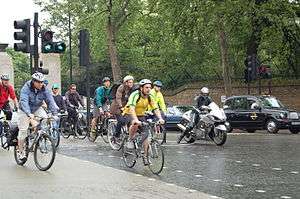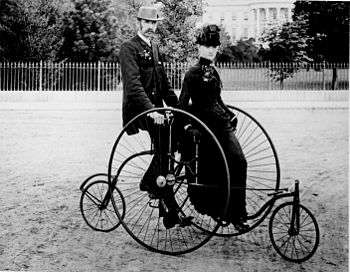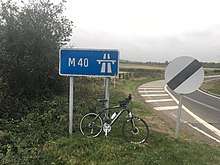Cycling in the United Kingdom
Cycling in the United Kingdom has a long history, since the earliest days of the bicycle, and after a decline in the mid-20th century has been undergoing a resurgence in recent decades.[1][2]

History

John Kemp Starley, a 19th-century English inventor is often considered the inventor of the modern bicycle. He began producing the Rover Safety Bicycle in 1885.
In the late 19th century, the city of Coventry was the largest producer of bicycles in the world.[3]
The National Clarion Cycling Club, which has member sections across the country, was started in the 1890s and was instrumental in the promotion of the socialist movement as well as the growth in popularity of cycling.
Utility cycling
The numbers of people commuting to work by bicycle increased by 17% to 760,000 in England and Wales between 2001 and 2011,[2] a total proportion of 2.9% of all commuters.[4]
At the governmental level, cycling is a responsibility of the Department for Transport. Cycling UK advocates in the areas of utility and recreational cyclists, as opposed to cycle sport which is governed by British Cycling.
Initiatives such as the Cycle to Work scheme are designed to encourage cycling as a mode of transport, particularly for its environmental benefits against automobile use.
The DfT administers the Bikeability national cycle training programme, which educates both children and adults in bike handling skills and safe cycling on public roads.[5]
Segregated Bicycle Paths
These are being installed in some cities in the UK such as London, Glasgow, Manchester, Bristol, Cardiff for example. In London Transport for London has the Cycle Superhighways. [6]
Cycle routes
The National Cycle Network, created by the charity Sustrans, is the UK's major network of signed routes for cycling. It uses dedicated bike paths as well as roads with minimal traffic, and covers 14,000 miles (23,000 kilometres), passing within 1 mi (2 km) of half of all homes.[7] Other cycling routes such as The National Byway, the Sea to Sea Cycle Route and local cycleways can be found across the country.
Cycle sport
The governing organisations for cycle sport in the UK is British Cycling and Cycling Ireland.
The 21st century has seen a dramatic increase in the performance of British cyclists at the top levels of international cycling. Great Britain dominated the medal tables in cycling at the 2008, 2012 and 2016 Olympics, while riders such as Bradley Wiggins, Mark Cavendish and Chris Froome have recorded multiple wins in professional road races such as the Tour de France.
Major professional road races include the Tour of Britain, the Tour de Yorkshire, The Women's Tour and the London–Surrey Classic. On the track, the Revolution series events are most prominent. London hosted the 2016 UCI Track Cycling World Championships.
The Tour de France included stages in Britain in 1974, 1994, 2007 and 2014.
Velodromes and other permanent tracks
There are five Olympic-size indoor velodromes in Britain: the Olympic Velodrome in Lee Valley VeloPark, Manchester Velodrome, the Sir Chris Hoy Velodrome, Wales National Velodrome and Derby Arena.
The National Indoor BMX Arena is located at the National Cycling Centre in Manchester.
Leisure and mass-participation cycling events
Well-known regular events amateur and leisure cyclists include RideLondon and the Dunwich Dynamo. More than 100,000 people took part in cyclosportives in 2014.[1]
Rules

Cyclists cannot use certain roads in the United Kingdom, most notably Motorways.[8] Further, some roads can be marked off-limits to cyclists by the presence of either a No Cycling sign (a bicycle in a red circle), or a No Vehicles sign (an empty red circle). In the latter case, cycles may be pushed.[9] Other than these restrictions, cyclists can use any public highway in the United Kingdom, such as A roads (including dual carriageways).
The use of dedicated cycle facilities is not compulsory, and use "depends on your experience and skills".[10] However, riding on the pavement is illegal.
Bicycles must furthermore be road-worthy, which in Great Britain means that the bicycle must have "two efficient braking systems" that operate independently on both wheels. This includes fixed-gear bicycles, where backwards pressure on the pedals acts as a brake, so only a front brake is required in this case.[10]
For riding in the hours of darkness between sunset and sunrise, cyclists must have at least a red rear light and a white front light, as well as a red rear reflector and four amber pedal reflectors (one at the back and one at the front on each pedal).[11]
See also
| Wikivoyage has a travel guide for Cycling in the United Kingdom. |
- Cycling in Cardiff
- Cycling in Leeds
- Cycling in London
- Cycling in Manchester
References
- Barney Thompson (3 April 2015). "British cyclists hit the road in record numbers". Financial Times. Retrieved 18 February 2016.
- Kaya Burgess (6 March 2013). "Commuting by bike soars by nearly a fifth". The Times. Retrieved 18 February 2016.
- "Coventry's Bicycle Heritage". Retrieved 18 February 2016.
- "Census reveals details of how we travel to work in England and Wales". Office for National Statistics. 13 February 2013. Retrieved 18 February 2016.
- "Bikeability gets kids in the saddle at Manchester City Football Club". British Cycling. 22 August 2013. Retrieved 20 February 2016.
- https://tfl.gov.uk/modes/cycling/routes-and-maps/cycle-superhighways
- "About the National Cycle Network". Retrieved 18 February 2016.
- "Motorways (253 to 273) - The Highway Code - Guidance - GOV.UK". www.gov.uk. Retrieved 4 July 2019.
- "Traffic signs - The Highway Code - Guidance - GOV.UK". www.gov.uk. Retrieved 4 July 2019.
- "What's legal - and what's not - on your bike? | Cycling UK". www.cyclinguk.org. Retrieved 4 July 2019.
- "Bike light laws in the UK: what you need to know". BikeRadar. Retrieved 4 July 2019.